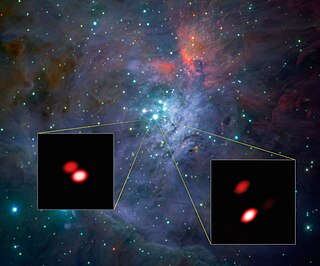Theta 1 Orionis C
|
Multiple star Theta 1 Orionis C |
|||||||||||||||||||
|---|---|---|---|---|---|---|---|---|---|---|---|---|---|---|---|---|---|---|---|

|
|||||||||||||||||||
| Bottom right a close-up of the double star Theta 1 Orionis C taken with the GRAVITY instrument of the VLTI . | |||||||||||||||||||
| AladinLite | |||||||||||||||||||
|
Observation dates equinox : J2000.0 , epoch : J2000.0 |
|||||||||||||||||||
| Constellation | Orion | ||||||||||||||||||
| Right ascension | 05 h 35 m 16.46 s | ||||||||||||||||||
| declination | -05 ° 23 ′ 22.9 ″ | ||||||||||||||||||
| Apparent brightness | 5.13 mag | ||||||||||||||||||
| Typing | |||||||||||||||||||
| B − V color index | +0.02 | ||||||||||||||||||
| U − B color index | −0.95 | ||||||||||||||||||
| R − I index | +0.18 | ||||||||||||||||||
| Spectral class | O7 V 09.5 ? |
||||||||||||||||||
| Astrometry | |||||||||||||||||||
| parallax | approx. 2.2 mas | ||||||||||||||||||
| distance | 1,340 ly 410 pc |
||||||||||||||||||
| Visual absolute brightness M vis | −3.20 mag | ||||||||||||||||||
| Proper movement | |||||||||||||||||||
| Rec. Share: | (−4.13 ± 4.79) mas / a | ||||||||||||||||||
| Dec. portion: | (6.82 ± 3.25) mas / a | ||||||||||||||||||
| Physical Properties | |||||||||||||||||||
| Dimensions | 33.5 12 1 M ☉ |
||||||||||||||||||
| radius | 8 R ☉ | ||||||||||||||||||
| Luminosity |
251000 L ☉ |
||||||||||||||||||
| Effective temperature | 45500 K | ||||||||||||||||||
| Rotation time | ~ 112 km / s | ||||||||||||||||||
| Age | 1.2 · 10 6 a | ||||||||||||||||||
|
Other names and catalog entries |
|||||||||||||||||||
|
|||||||||||||||||||
| annotation | |||||||||||||||||||
|
|||||||||||||||||||
Theta 1 Orionis C ( θ 1 Orionis C , θ 1 Ori C , also 41 Ori C ) is a multiple star system and the brightest star of the trapezoid in the Orion Nebula . When viewed from the earth, its components C1 and C2 have an angular distance of 0 "04, i.e. 4 hundredths of an arc second . C3 even circles C1 at a much smaller distance.
Theta 1 Orionis C1 is a Blue giant (34 solar masses) of the main sequence , the characteristics of the spectral O shows. Its surface temperature is extremely high at 45,000 K. The estimated absolute brightness in visible light is −3.2. It is one of the brightest known stars. Because of the quite large distance of approx. 1500 light years , the apparent brightness is only at a magnitude of 5.1.
Theta 1 Orionis C1 produces most of the ultraviolet radiation that ionizes the Orion Nebula and thus also causes its glow. It also produces a stellar wind that is around 100,000 times stronger than that of the sun. The particles of the stellar wind move at 1,000 km / s. Theta 1 Orionis C1 is still a variable X-ray source . A plasma bubble that is millions of degrees hot, generated by the star wind, also generates X-rays.
The Orion Nebula is expanding due to the star wind. Various maximum expansion speeds relative to the trapezoidal stars could already be measured from the late 1950s on the basis of emission lines of various ions and the 21 cm radio emission of neutral hydrogen.
The stars of the trapezoid are perceived as a single star with the naked eye (Theta 1 Orionis). Most of the light from Theta 1 Orionis, however, comes from its component C. It can therefore be said that Theta 1 Orionis C1 has the highest surface temperature of all stars visible to the naked eye.
The star is likely to explode as a supernova in a few million years .
Theta 1 Orionis C1 has 2 other companions. Theta 1 Orionis C2 with spectral class O9.5 has about 12 solar masses and is about 18 AU away. Another companion C3 circles the large component C1 at a narrow distance of only about 0.4 AU.
literature
- Marc Gagne, et al. : Periodic X-ray emission from the O7 V Star θ 1 Orionis C . In: Astrophysical Journal Letters . 478, No. 2, 1997, pp. L87-L90. doi : 10.1086 / 310558 .
- NR Walborn: Systematic variations in the spectrum of Theta 1 Orionis C . In: Astrophysical Journal . 243, No. 1, 1981, pp. L37-L39. doi : 10.1086 / 183438 .
Web links
- Theta-1 Orionis by James B. Kaler.
Individual evidence
- ↑ tet01 Ori C. In: SIMBAD . Center de Données astronomiques de Strasbourg , accessed April 14, 2019 .
- ^ Hipparcos catalog (ESA 1997)
- ↑ a b c Bright Star Catalog
- ↑ a b c GRAVITY collaboration: Multiple star systems in the Orion nebula . In: Astronomy & Astrophysics . 620, 2018, p. A116. arxiv : 1809.10376 . bibcode : 2018A & A ... 620A.116G . doi : 10.1051 / 0004-6361 / 201833575 .
- ^ Hipparcos, the New Reduction (van Leeuwen, 2007)
- ↑ https://www.mpia.de/news/wissenschaft/2007-10-orion-nebel Manuel Güdel: Millions of degrees hot gas discovered in the Orion Nebula , message from the Max Planck Institute for Astronomy on November 30, 2007, accessed on March 13, 2020
- ↑ http://articles.adsabs.harvard.edu/cgi-bin/nph-iarticle_query?bibcode=1967ApJ...148..925K&db_key=AST&page_ind=1&plate_select=NO&data_type=GIF&type=SCREEN_GIF&classic=YES Kaler, JB: Radial Velocities in the Orion Nebula , in: Astrophysical Journal, Vol. 148 (1967), p. 925 BibCode: 1967ApJ ... 148..925K, accessed on March 13, 2020

